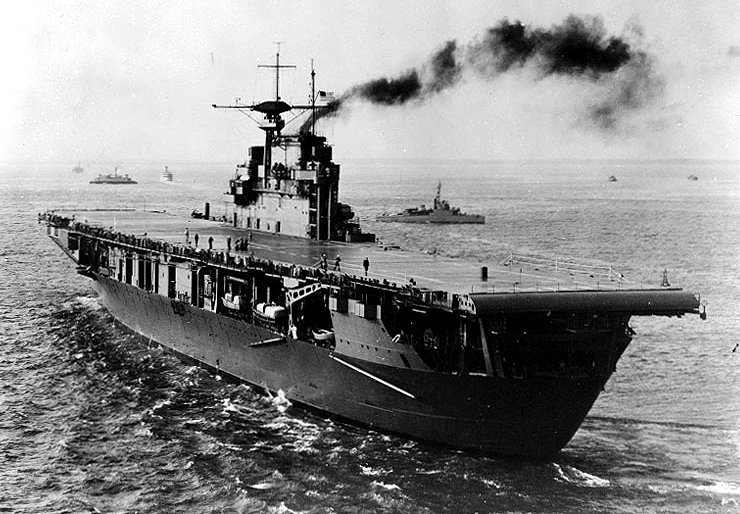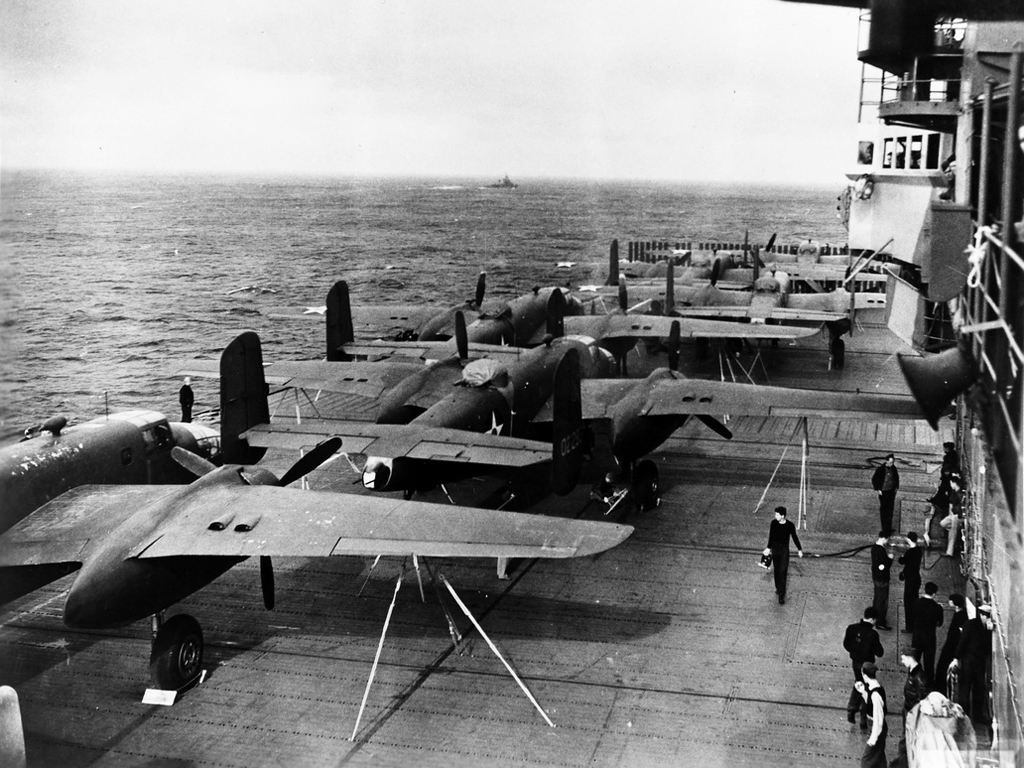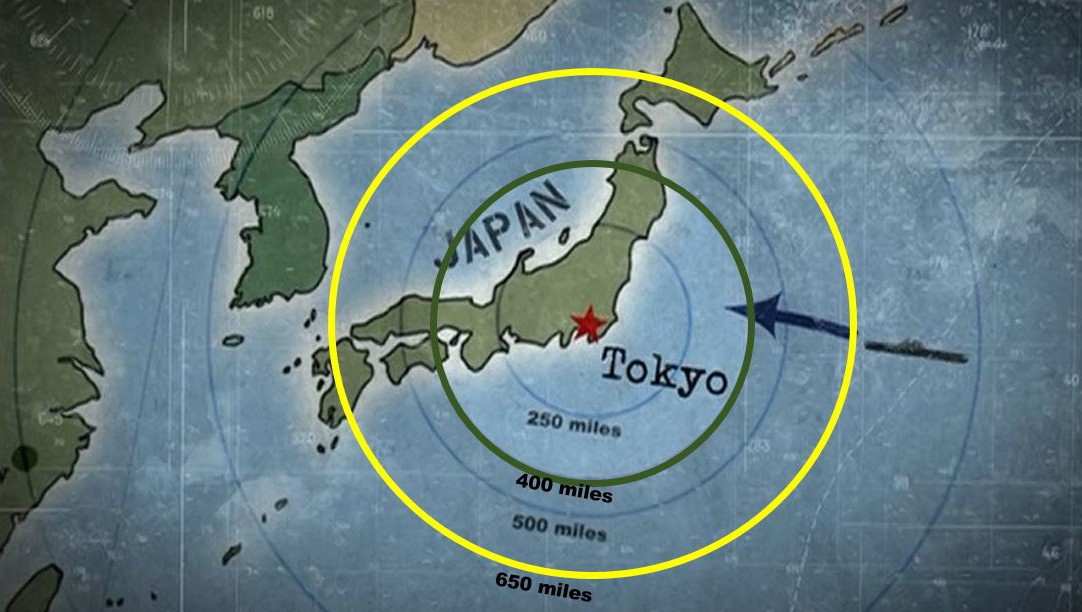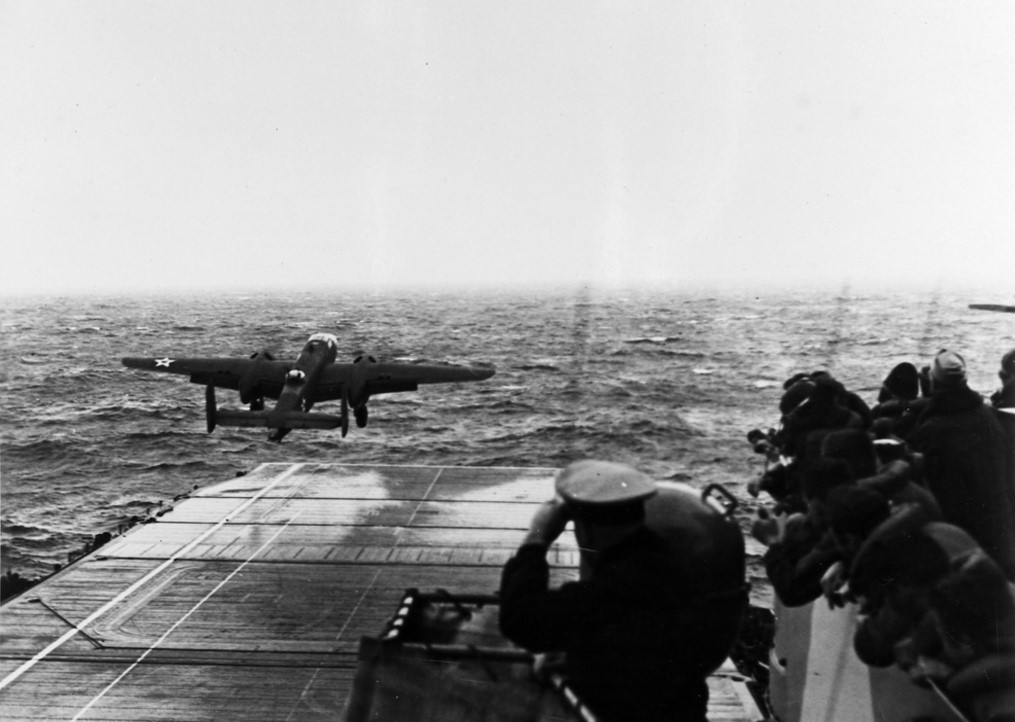In the early hours of April 18, 1942, just over four months after the Japanese surprise attack on Pearl Harbor, the USS Hornet, escorted by its sister aircraft carrier, the USS Enterprise, got within 650 miles of Tokyo when it was spotted by a Japanese patrol boat. The Hornet, on its maiden voyage, was on a mission to launch 16 B-25 Mitchell bombers off its deck to strike Tokyo and other Japanese cities as retribution for Pearl Harbor. The Enterprise was accompanying to provide protection from Japanese air attack, as the Hornet’s fighters were below deck to make room for the B-25 bombers.
This photo provides an excellent view of the Hornet’s deck.
The photo below shows six of the 16 B-25 Mitchells staggered on the deck of the Hornet. With a 67-foot wingspan, the B-25 Mitchell barely fit on the deck. Note that the port-side wings of the aircraft on the left overhang the deck. Fearing the mission had lost the element of surprise and the carriers would come under attack, Admiral William “Bull” Halsey, who was in overall command of the carrier task force, ordered the B-25 bombers to launch, despite the fact that the Hornet was to get within 400 miles from the coast of Japan — still 250 miles away. Although the 1,300 mile range of the B-25 bombers was significantly increased for the mission, the bombers would be lucky to hit their targets in Japan and still have enough fuel to make it to landing strips just outside occupied China.
Fearing the mission had lost the element of surprise and the carriers would come under attack, Admiral William “Bull” Halsey, who was in overall command of the carrier task force, ordered the B-25 bombers to launch, despite the fact that the Hornet was to get within 400 miles from the coast of Japan — still 250 miles away. Although the 1,300 mile range of the B-25 bombers was significantly increased for the mission, the bombers would be lucky to hit their targets in Japan and still have enough fuel to make it to landing strips just outside occupied China.
I’ve modified the map below, captured from Battle 360: Season One, Call to Duty episode to provide a graphic sense of the distances involved. The green circle, at 400 miles, shows how far the Hornet needed to reach for the B-25 bombers to strike their targets and safely land in China. The yellow circle, at 650 miles, shows how far the Hornet actually got before launching the bombers. One by one, the 16 B-25 bombers, each with a five-man crew and carrying 2,000 pounds of explosives, precariously took off from the deck of the Hornet on their four-hour flight to their targets. Colonel James Doolittle, who had planned and led the operation, was the first and, being at the front of the line, had the least runway to take off.
One by one, the 16 B-25 bombers, each with a five-man crew and carrying 2,000 pounds of explosives, precariously took off from the deck of the Hornet on their four-hour flight to their targets. Colonel James Doolittle, who had planned and led the operation, was the first and, being at the front of the line, had the least runway to take off.
The feat warrants explanation. For obvious reasons, aircraft carriers provide a limited stretch of runway. Aircraft-based fighter planes are specifically designed so they can take off from the short runways on a carrier. Larger bomber planes are a horse of a different color. The B-25 Mitchell, a medium-sized bomber, required 1,500 feet of runway and a speed of 90 mph to take off. With 16 medium-sized bombers parked on the rear of its 814-foot-long deck, the Hornet afforded the Mitchells only 500 feet of runway — one-third of the required length — and permitted acceleration to only 50 mph. In fact, Col. Doolittle’s bomber only had 467 feet of runway.
To accomplish such take-off, the aircraft were supplied with high octane fuel, while the carrier was positioned so that the bombers could take off against the wind, providing them additional lift. Although the aircraft were also stripped of all non-essential equipment to lessen their weight, that reduction was offset by the extra fuel to allow them to reach and land in China, as it would be impossible to return and land an aircraft the size of a Mitchell on a carrier.  All 16 B-25 bombers took off safely, though at least two dipped down after leaving the deck and seemed to skim the “drink” dangerously before finally lifting up and continuing their trajectory to their targets. While some encountered resistance from Japanese fighter planes, all successfully completed their mission, each dropping four 500-lb bombs on Tokyo, Kobe, Nagoya, Osaka, Yokohama, or Yokosuka. It bears noting that all targets were military — factories, munitions plants, shipyards — though the crews understood that there would be civilian casualties.
All 16 B-25 bombers took off safely, though at least two dipped down after leaving the deck and seemed to skim the “drink” dangerously before finally lifting up and continuing their trajectory to their targets. While some encountered resistance from Japanese fighter planes, all successfully completed their mission, each dropping four 500-lb bombs on Tokyo, Kobe, Nagoya, Osaka, Yokohama, or Yokosuka. It bears noting that all targets were military — factories, munitions plants, shipyards — though the crews understood that there would be civilian casualties.
I couldn’t resist including this fabulous centerfold painting from The Doolittle Raid 1942, Osprey Campaign 156, by Clayton Chun. The painting is by Howard Gerrard. It is posted here for discussion purposes under the fair use exception to the copyright laws. As a result of the additional fuel consumption caused by the premature launch, 15 of the 16 aircraft either crash-landed in China or were ditched at sea, killing three crew members. Japanese soldiers in occupied China captured eight crew members and later executed three, while one died in captivity. Only one aircraft, dangerously low on fuel, managed to land safely by flying to the Soviet Union, which was closer than China, though its five crew members were held by the Soviets for more than a year. Thus, of the 80 crew members who participated in the Doolittle Raid, seven never returned.
As a result of the additional fuel consumption caused by the premature launch, 15 of the 16 aircraft either crash-landed in China or were ditched at sea, killing three crew members. Japanese soldiers in occupied China captured eight crew members and later executed three, while one died in captivity. Only one aircraft, dangerously low on fuel, managed to land safely by flying to the Soviet Union, which was closer than China, though its five crew members were held by the Soviets for more than a year. Thus, of the 80 crew members who participated in the Doolittle Raid, seven never returned.
While the Doolittle Raid caused negligible damage to Tokyo or other cities, the psychological impact on Japanese morale was immense. Japanese leaders had convinced the populace that Japan was invulnerable to surprise attacks. The Doolittle Raid dispelled this myth and sowed doubt in the Japanese public about its leadership. Moreover, the raid showed the Japanese that the islands were not immune to American bombs, persuading Japanese officials to pull troops from the field to protect the home islands and ships from the Pacific to patrol the coasts. More importantly, it convinced Japanese officials that it was imperative to destroy the U.S. fleet once and for all — something they had failed to do at Pearl Harbor — prompting them to gamble most of their fleet at the Battle of Midway, which was to prove disastrous to the Imperial Japanese Navy.
Conversely, the Doolittle Raid provided a significant morale boost for Americans, particularly its fighting forces, many of whom harbored a thirst for revenge. The Raid also marked the first time that medium bombers had launched from an aircraft carrier and is a textbook example of successful joint Air Force/Navy operations.
Today, 74 years after that fateful day, let us remember the 80 men who selflessly and courageously volunteered for an operation that was in all respects a suicide mission. Of those 80 brave men, only two remain alive today.
I hope you enjoyed the post. Stay tuned next week for Part 2, regarding available B-25 Mitchell bombers in 1/72 scale specifically representing the Doolittle Raid.
